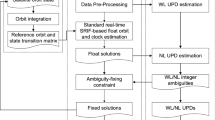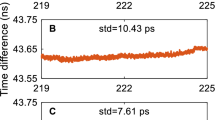Abstract
Real-time clock products are essential and a prerequisite for global navigation satellite system (GNSS) real-time applications, which are usually estimated from real-time observations from reference stations of a ground network without fixing the phase ambiguities. To improve the precision of real-time clock products further, an undifferenced ambiguity fixing algorithm is proposed for the classical real-time clock estimation method without requiring modifications to the current data processing strategy and product consistency. Combined with the wide-lane (WL) ambiguities, the ionospheric-free (IF) ambiguity estimates generated by the traditional clock estimation method are fed to an independent ambiguity fixing process to estimate the WL and narrow-lane (NL) uncalibrated phase delays (UPDs) and fix the WL/NL undifferenced ambiguities at each epoch. The fixed IF ambiguities are recovered from these WL/NL UPDs and integer ambiguities and then used to constrain the float-ambiguity clock solution. The proposed strategy is tested on 30 days of observations of 85 globally distributed reference stations of the international GNSS service (IGS) and multi-GNSS experiment (MGEX) networks. In the experiment, 99.96% of the post-fit residuals of WL ambiguities and 99.31% of the post-fit residuals of NL ambiguities fall in the range of (− 0.3, 0.3), with standard deviations (STD) of 0.045 and 0.074 cycles, respectively, which demonstrates the high precision and consistency of UPDs and fixed ambiguities. With the constraint of fixed ambiguities, the traditional float-ambiguity clock solution is further refined, resulting in ambiguity-fixed clock solution. Comparison with the IGS 30 s final clock products shows that ambiguity-fixing brings as much as 50–87% precision improvement to the float-ambiguity clock solution, and with an average improvement over 30 days of 24–50% for each satellite. When used in the float-ambiguity kinematic PPP test, the ambiguity-fixed clock brings at least 5% improvement to the north component and at least 10% improvement to the east and vertical components.









Similar content being viewed by others
References
Abdelazeem M, Çelik RN, El-Rabbany A (2016) An Enhanced real-time regional ionospheric model using IGS real-time service (IGS-RTS) products. J Navig 69(3):521–530. https://doi.org/10.1017/S0373463315000740
Bierman GJ (1982) Square-root information filtering and smoothing for precision orbit determination. In: Sorensen DC, Wets RJ-B (eds) Algorithms and theory in filtering and control. Springer, Berlin, Heidelberg, pp 61–75
Blewitt G (1989) Carrier phase ambiguity resolution for the global positioning system applied to geodetic baselines up to 2000 km. J Geophys Res Solid Earth 94(B8):10187–10203. https://doi.org/10.1029/JB094iB08p10187
Boehm J, Werl B, Schuh H (2006) Troposphere mapping functions for GPS and very long baseline interferometry from European Centre for Medium-Range Weather Forecasts operational analysis data. J Geophys Res Solid Earth 111(B02406):1–9. https://doi.org/10.1029/2005JB003629
Böhm J, Möller G, Schindelegger M, Pain G, Weber R (2014) Development of an improved empirical model for slant delays in the troposphere (GPT2w). GPS Solut 19(3):433–441. https://doi.org/10.1007/s10291-014-0403-7
Collins P, Lahaye F, Heroux P, Bisnath S (2008) Precise point positioning with ambiguity resolution using the decoupled clock model. In: Proc. ION GNSS 2008, Institute of Navigation, Savannah, Georgia, USA, pp 1315–1322
Dai Z, Dai X, Zhao Q, Bao Z, Li C (2018) Multi-GNSS real-time clock estimation using the dual-thread parallel method. Adv Space Res 62(9):2518–2528. https://doi.org/10.1016/j.asr.2018.07.011
Dong D-N, Bock Y (1989) Global positioning system network analysis with phase ambiguity resolution applied to crustal deformation studies in California. J Geophys Res Solid Earth 94(B4):3949–3966. https://doi.org/10.1029/JB094iB04p03949
El-Mowafy A, Deo M, Kubo N (2017) Maintaining real-time precise point positioning during outages of orbit and clock corrections. GPS Solut 21(3):937–947. https://doi.org/10.1007/s10291-016-0583-4
Elsobeiey M, Al-Harbi S (2016) Performance of real-time Precise Point Positioning using IGS real-time service. GPS Solut 20(3):565–571. https://doi.org/10.1007/s10291-015-0467-z
Fu W, Yang Y, Zhang Q, Huang G (2018) Real-time estimation of BDS/GPS high-rate satellite clock offsets using sequential least squares. Adv Space Res 62(2):477–487. https://doi.org/10.1016/j.asr.2018.04.025
Gabor MJ, Nerem RS (1999) GPS carrier phase ambiguity resolution using satellite-satellite single differences. In: Proc. ION GPS 1999, Institute of Navigation, Nashville, Tennessee, USA, pp 1569–1578
Gabor MJ, Nerem RS (2002) Satellite–satellite single-difference phase bias calibration as applied to ambiguity resolution. Navigation 49(9):223–242. https://doi.org/10.1002/j.2161-4296.2002.tb00270.x
Ge M, Gendt G, Dick G, Zhang FP (2005) Improving carrier-phase ambiguity resolution in global GPS network solutions. J Geodesy 79(1–3):103–110. https://doi.org/10.1007/s00190-005-0447-0
Ge M, Gendt G, Dick G, Zhang FP, Rothacher M (2006) A New Data Processing Strategy for Huge GNSS Global Networks. J Geodesy 80(4):199–203. https://doi.org/10.1007/s00190-006-0044-x
Ge M, Gendt G, Rothacher M, Shi C, Liu J (2008) Resolution of GPS carrier-phase ambiguities in precise point positioning (PPP) with daily observations. J Geodesy 82(7):389–399. https://doi.org/10.1007/s00190-007-0187-4
Ge M, Chen J, Douša J, Gendt G, Wickert J (2012a) A computationally efficient approach for estimating high-rate satellite clock corrections in realtime. GPS Solut 16(1):9–17. https://doi.org/10.1007/s10291-011-0206-z
Ge M, Douša J, Li X, Ramatschi M, Nischan T, Wickert J (2012b) A novel real-time precise positioning service system: global precise point positioning with regional augmentation. J Glob Position Syst 11(1):2–10. https://doi.org/10.5081/jgps.11.1.2
Geng J, Meng X, Dodson AH, Teferle FN (2010) Integer ambiguity resolution in precise point positioning: method comparison. J Geodesy 84(9):569–581. https://doi.org/10.1007/s00190-010-0399-x
Geng J, Shi C, Ge M, Dodson AH, Lou Y, Zhao Q, Liu J (2012) Improving the estimation of fractional-cycle biases for ambiguity resolution in precise point positioning. J Geodesy 86(8):579–589. https://doi.org/10.1007/s00190-011-0537-0
Hatch R (1983) The synergism of GPS code and carrier measurements. In: International geodetic symposium on satellite doppler positioning, Las Cruces, New Mexico, USA, pp 1213–1231
Hauschild A, Montenbruck O (2008) Real-time clock estimation for precise orbit determination of LEO-satellites. In: Proc. ION GNSS 2008, Institute of Navigation, Savannah, Georgia, USA, pp 581–589
Hauschild A, Montenbruck O (2009) Kalman-filter-based GPS clock estimation for near real-time positioning. GPS Solut 13(3):173–182. https://doi.org/10.1007/s10291-008-0110-3
Hoechner A, Ge M, Babeyko AY, Sobolev SV (2013) Instant tsunami early warning based on real-time GPS—Tohoku 2011 case study. Nat Hazards Earth Syst Sci 13(5):1285–1292. https://doi.org/10.5194/nhess-13-1285-2013
Jing-nan L, Mao-rong G (2003) PANDA software and its preliminary result of positioning and orbit determination. Wuhan Univ J Nat Sci 8(2):603–609. https://doi.org/10.1007/BF02899825
Kouba J, Héroux P (2001) Precise point positioning using IGS orbit and clock products. GPS Solut 5(2):12–28. https://doi.org/10.1007/PL00012883
Laurichesse D, Mercier F (2007) Integer ambiguity resolution on undifferenced GPS phase measurements and its application to PPP. In: Proc. ION GNSS 2007, institute of navigation, Fort Worth, Texas, USA, pp 839–848
Laurichesse D, Mercier F, Berthias JP, Bijac J (2008) Real time zero-difference ambiguities fixing and absolute RTK. Proc. ION NTM 2008, Institute of Navigation, San Diego, California, USA, pp 747–755
Laurichesse D, Mercier F, Berthias J-P, Broca P, Cerri L (2009) Integer ambiguity resolution on undifferenced GPS phase measurements and its application to PPP and satellite precise orbit determination. Navig J Inst Navig 56(2):135–149
Laurichesse D, Cerri L, Berthias JP, Mercier F (2013) Real time precise gps constellation and clocks estimation by means of a Kalman filter. In: Proc. ION GNSS + 2013, institute of navigation, Nashville, Tennessee, pp 1155–1163
Lee S-W, Kouba J, Schutz B, Kim DH, Lee YJ (2013) Monitoring precipitable water vapor in real-time using global navigation satellite systems. J Geodesy 87(10–12):923–934. https://doi.org/10.1007/s00190-013-0655-y
Li X, Zhang X (2012) Improving the estimation of uncalibrated fractional phase offsets for PPP ambiguity resolution. J Navig 65(3):513–529. https://doi.org/10.1017/S0373463312000112
Li X, Ge M, Zhang X, Zhang Y, Guo B, Wang R, Klotz J, Wickert J (2013) Real-time high-rate co-seismic displacement from ambiguity-fixed precise point positioning: application to earthquake early warning. Geophys Res Lett 40(2):295–300. https://doi.org/10.1002/grl.50138
Melbourne W (1985) The case for ranging in GPS based geodetic systems. In: Proceedings of the 1st international symposium on precise positioning with the global positioning system, Rockville, Maryland, USA, pp 73–386
Mervart L, Lukes Z, Rocken C, Iwabuchi T (2008) Precise point positioning with ambiguity resolution in real-time. In: Proc. ION GNSS 2008, Institute of Navigation, Savannah, Georgia, USA, pp 397–405
Saastamoinen J (1972) Contributions to the theory of atmospheric refraction. Bull Geodesy 105(1):279–298. https://doi.org/10.1007/BF02521844
Shi J, Gao Y (2013) A comparison of three PPP integer ambiguity resolution methods. GPS Solut 18(4):519–528. https://doi.org/10.1007/s10291-013-0348-2
Teunissen PJG (1995) The least-squares ambiguity decorrelation adjustment: a method for fast GPS integer ambiguity estimation. J Geodesy 70(1–2):65–82. https://doi.org/10.1007/BF00863419
Teunissen PJG, Khodabandeh A (2014) Review and principles of PPP-RTK methods. J Geodesy 89(3):217–240. https://doi.org/10.1007/s00190-014-0771-3
Wu JT, Wu SC, Hajj GA, Bertiger WI, Lichten SM (1992) Effects of antenna orientation on GPS carrier phase. In: Proc. AAS/AIAA astrodynamics, Durango, Colorado, USA, pp 1647–1660
Wübbena G (1985) Software developments for geodetic positioning with GPS using TI-4100 code and carrier measurements. In: Proceedings 1st international symposium on precise positioning with the global positioning system. Rockville, Maryland, USA, pp 403–412
Yao Y, He Y, Yi W et al (2017) Method for evaluating real-time GNSS satellite clock offset products. GPS Solut 21(4):1417–1425. https://doi.org/10.1007/s10291-017-0619-4
Zhang X, Li X, Guo F (2011) Satellite clock estimation at 1 Hz for realtime kinematic PPP applications. GPS Solut 15(4):315–324. https://doi.org/10.1007/s10291-010-0191-7
Zhang W, Lou Y, Gu S, Shi C, Haase JS, Liu J (2015) Joint estimation of GPS/BDS real-time clocks and initial results. GPS Solut 20(4):665–676. https://doi.org/10.1007/s10291-015-0476-y
Acknowledgements
The experiment data is collected from the IGS and MGEX networks. The author would like to thank the editor and reviewers. This work was supported by the Excellent Scientist Foundation of Hube (Grant no. 2018CFA052), Guangzhou (China) Post-doctoral International Training Program (Grant no. 20173096), National Science Foundation for Post-doctoral Scientists of China (Grant no. 2018M632918).
Author information
Authors and Affiliations
Corresponding author
Additional information
Publisher’s Note
Springer Nature remains neutral with regard to jurisdictional claims in published maps and institutional affiliations.
Rights and permissions
About this article
Cite this article
Dai, Z., Dai, X., Zhao, Q. et al. Improving real-time clock estimation with undifferenced ambiguity fixing. GPS Solut 23, 44 (2019). https://doi.org/10.1007/s10291-019-0837-z
Received:
Accepted:
Published:
DOI: https://doi.org/10.1007/s10291-019-0837-z




